It is thanks to nature's gifts that we are able to operate and develop. Now we want to repay the environment - by investing in green solutions and planet-friendly transportation.
GMP+ standard
We operate in accordance with the GMP standard - quality requirements for feed safety. This standard is mandatory for producers, processors, traders and transport companies that participate in the food chain, which guarantees the highest quality of our services.
Ecodriving
All of our drivers undergo both theoretical and practical ecodriving training, which allows them to reduce their consumption of fuel and consumable parts on a daily basis, and reduce carbon dioxide and heavy metal emissions into the atmosphere.
Optimization of routes and cargo
We use an advanced, computerized forwarding system that allows us to determine the most efficient routes and transportation schedules. As a result, our vehicles cover only the necessary distances, which reduces the carbon footprint and improves transportation economics.
Full fleet efficiency
We keep our fleet in full working order with regular inspections and services performed both at authorized facilities and in our own workshop. This, combined with the experience of our drivers, increases the safety of transports and optimizes fuel consumption.
Specialized trailers
We have a wide selection of specialized trailers. We use belt trailers for transporting agricultural crops, which minimize damage to goods during loading, transportation and unloading, helping to reduce food waste.
Environmental protection and LNG technology - our answer to sustainability
Sustainability is the cornerstone of our business strategy. We make sure that Sobanscy Transport's operations support environmental protection and the development of local communities and the agricultural industry. We invest in a modern, low-emission fleet of vehicles fueled by LNG (liquefied natural gas) and BioLNG, which minimize the impact of transportation on the atmosphere due to its purity and low emissions. LNG is made by purifying natural gas and cooling it to about -160°C, making it colorless, odorless and free of toxic compounds. Its main ingredient is methane, and the use of this fuel allows us to realize the goals of the European Green Deal and support the transformation of transportation towards ecology. We carry out each order with full commitment, combining reliability, timeliness and honesty with concern for the welfare of customers and the environment. We build lasting business relationships based on trust and professionalism, aware of the responsibility that our activities carry.


Certifications and environmental benefits
Our BioLNG fuel has official certifications confirming its high quality and environmental performance. By using BioLNG, we have reduced CO₂e emissions by 548.92 tons compared to standard diesel fuel. This is our real contribution to climate protection and concern for future generations.
Download ourBioLNG certification
Benefits of LNG for transportation
Save
LNG fuel is cheaper than diesel fuel with comparable performance.
LNG fuel is cheaper than diesel fuel with comparable performance. A kilogram of liquefied natural gas costs less than a liter of diesel fuel, while being nearly 40% more energy efficient.
Security
On contact with air, LNG vaporizes and dilutes in the air.
If it comes into contact with air, LNG vaporizes and dilutes in the air. In the event of an LNG spill, there is no possibility of environmental contamination. It is a much less harmful and dangerous fuel than, for example, oil or LPG. Natural gas in its liquid form is also not ignitable.
Quieter operation of vehicles
LNG-fueled engines run quieter than diesel engines.
Less pollution
When burned, LNG fuel emits 3 times less sulfur oxides into the atmosphere.
Similarly, it emits 3 times less particulate matter, nitrogen oxides and other greenhouse gases compared to diesel combustion in diesel engines.
Performance
When natural gas is liquefied in LNG, its volume is reduced by about 600 times.
When natural gas is liquefied in LNG, its volume is reduced by about 600 times. This means that after regasification from 100 m3 of LNG we get 60 thousand m3 of natural gas.
Availability
The world's abundant natural gas resources and the support of international organizations as well as state governments are the basis of distribution for LNG fuel.
Currently, the European Union is the world's largest importer of LNG, and the United States is its largest supplier.


